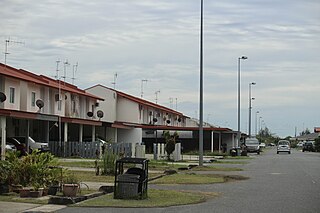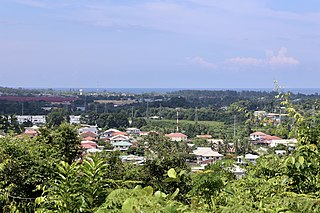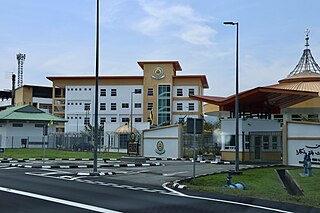
Belait District, or simply Belait, is the largest as well as the westernmost district in Brunei. It has an area of 2,727 square kilometres (1,053 sq mi) and the population of 69,062 as of 2016. The administrative town is Kuala Belait, located at the mouth of the Belait River. The district is commonly associated with the oil and gas industry of the country, mainly concentrated near the town of Seria.
The administrative divisions of Brunei Darussalam mainly consist of daerah (districts), mukim (sub-districts), and kampung or kampong (villages). They are organised hierarchically in Brunei Darussalam, with daerah being the largest first level, and kampong the smallest third level.

Panaga is a coastal settlement on the north-east coast of the island of Borneo, in the Bruneian district of Belait. Officially known as Kampong Panaga, it is a village-level subdivision under Seria, a mukim or subdistrict of Belait. The settlement of Panaga comprises a public housing estate under the National Housing Scheme and the housing estate of Brunei Shell Petroleum (BSP), the main oil and gas company in the country. Panaga is also home to the headquarters of the company itself. The postcode for Panaga is KB4533.

Mukim Seria is a mukim in Belait District, Brunei. It has an area of 169 square kilometres (65 sq mi); the population was 21,214 in 2016. The mukim encompasses Seria, one of the only two towns in the district. It is home to the oil and gas industry of the country.

Kampong Mumong, or simply known as Mumong, is a residential suburb of Kuala Belait, the principal town of Belait District, in Brunei Darussalam. It comprises the original Mumong settlement, as well as the Mumong public housing estate of the Landless Indigenous Citizens' Housing Scheme. However, it officially consists of two village sub-divisions, namely Mumong 'A' and Mumong 'B', which are under the mukim of Kuala Belait.

Rasau is an area in Brunei. The area contains one of the two oil fields of Brunei, the Rasau Field, and a small village, Kampong Rasau, which has a population of 103.

Mukim Labi is a mukim in the interior of Belait District, Brunei. It has an area of 361.8 square kilometres (139.7 sq mi); the population was 1,216 in 2016.

Mukim Bukit Sawat is a mukim in Belait District, Brunei. It had a population of 794 in 2016.

Mukim Kilanas is a mukim in Brunei-Muara District, Brunei. The population was 22,492 in 2016.

Mukim Rambai is a mukim in Tutong District, Brunei. The population was 1,404 in 2016.

Mukim Tanjong Maya is a mukim in Tutong District, Brunei. The population was 4,062 in 2016.

Mukim Kuala Balai is a mukim in Belait District, Brunei. The population was 31 in 2016.

Mukim Liang is a mukim in Belait District, Brunei. The population was 14,301 in 2016.

Mukim Sukang is a mukim in Belait District, Brunei. The population was 169 in 2016.

Mukim Bangar is a mukim in Temburong District, Brunei. It has a total area of 113 square kilometres (44 sq mi); the population was 2,112 in 2021. The mukim encompasses Bangar, the district's sole town and administrative centre.

Mukim Batu Apoi is a mukim in Temburong District, Brunei. It has an area of 222 square kilometres (86 sq mi); as of 2021, the population was 1,355.

Kampong Lumut or commonly known as Lumut, is a coastal settlement in Belait District, Brunei Daurssalam, about 30 kilometres from the district town Kuala Belait. The total population was 11,273 in 2016.

Kampong Pandan or simply known as Pandan, is a residential area in Kuala Belait, the principal town of Belait District, Brunei. It has a population of around 16,200 in 2016. It encompasses a housing estate of the country's National Housing Scheme.

Kampong Danau, simply known as Danau, is a coastal village in Tutong District, Brunei, about 21 kilometres (13 mi) from the district town Pekan Tutong. It has a total area of 6.5023 square kilometres (2.5106 sq mi); the total population was 1,072 in 2016. It is one of the villages within Mukim Telisai.

Kampong Sungai Liang or simply Sungai Liang, is a village in Belait District, Brunei, about 40 kilometres (25 mi) from the district's principal town Kuala Belait and 20 kilometres (12 mi) from the oil town Seria. The population was 910 in 2016. It is one of the villages within Mukim Liang. The postcode is KC1135.






















